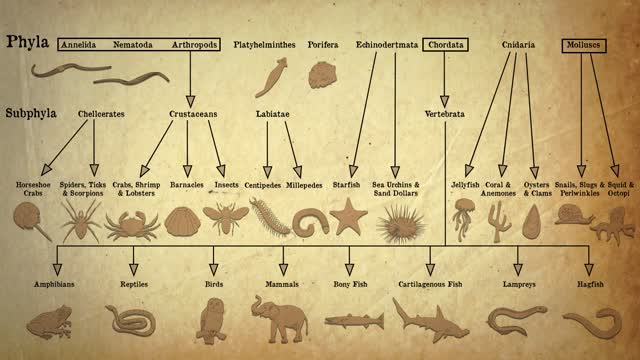Premium Only Content

Animal Classification | Evolution | Biology | FuseSchool
All living things are grouped into 5 kingdoms. In this video we are going to look at the animal kingdom in more detail. There are thought to be over 7.5 million species of animal on planet Earth, of which 900,000 have been described.
These are arranged into over 30 phyla, of which these are the 9 most common: Porifera, Cnidaria, Platyhelminthes, Nematoda, Mollusca, Annelida, Arthropoda, Echinodermata and Chordata.
These are the 5 main animal phyla: Arthropods, annelids, molluscs, nematodes and the chordata.
A big question to ask is “Do they have a backbone?” If yes, they are a vertebrate. If no, they are an invertebrate.
The chordata contain all of the vertebrates. Not all chordates are vertebrates, but all vertebrates are chordates.
There are many different classes of vertebrate, but the 5 most well known ones are the fish, birds, amphibians, mammals, reptiles. Each class has different characteristics that defines them. Like mammals which have fur or hair, feed their young on milk and are warm-blooded. Sometimes people aren’t too sure whether something is a reptile or an amphibian. Reptiles have scaly skin, breathe air and usually live on land - except for turtles. Snakes, lizards, turtles, tortoises, crocodiles, and alligators are all reptiles. Amphibians live double lives. They start in water and breathe with gills, and as they grow older they grow lungs - Frogs, toads, salamanders.
Once inside a class - so mammals for example - different species are grouped together in even more detail. There are about 5000 species of mammals, classified into 3 subclasses and about 26 orders.
Back to the 5 main animal phyla: Arthropods, annelids, molluscs, nematodes and the chordata.
Arthropods all have a hard exoskeleton, and have jointed legs. Spiders are not insects… they are different classes of arthropods. And, just like in animals these classes break down even further.
SUBSCRIBE to the FuseSchool YouTube channel for many more educational videos. Our teachers and animators come together to make fun & easy-to-understand videos in Chemistry, Biology, Physics, Maths & ICT.
VISIT us at www.fuseschool.org, where all of our videos are carefully organised into topics and specific orders, and to see what else we have on offer. Comment, like and share with other learners. You can both ask and answer questions, and teachers will get back to you.
These videos can be used in a flipped classroom model or as a revision aid.
-
 LIVE
LIVE
Glenn Greenwald
53 minutes agoWeek in Review: Lee Fang and Leighton Woodhouse on Ukraine War and NYT Piece Revealing Tensions within Trump Admin; PLUS: Lee Fang Takes Audience Questions on DOGE and Big Tech | SYSTEM UPDATE #420
660 watching -
 LIVE
LIVE
Sarah Westall
3 hours agoMassive Government Overhaul: FBI, CIA, IRS and more to be Gutted w/ Sam Anthony
443 watching -
 LIVE
LIVE
Quite Frankly
5 hours ago"News Round-Up, Celebrity Stories, Friday Extras" ft. J Gulinello 3/7/25
198 watching -
 UPCOMING
UPCOMING
LFA TV
23 hours agoGermany Started Two World Wars and Now Wants Nuclear Weapons | TRUMPET DAILY 3.7.25 7PM
1.84K -
 LIVE
LIVE
2 MIKES LIVE
1 hour ago2 MIKES LIVE #189 Open Mike Friday (Sort Of)
85 watching -
 1:48:14
1:48:14
Right Side Broadcasting Network
9 hours agoLIVE REPLAY: President Trump Delivers Remarks at The White House Digital Assets Summit - 3/7/25
115K40 -
 2:07:17
2:07:17
The Quartering
7 hours agoTrump Goes Ballistic On Russia & Ukraine Gets Results, Democrat Cringe, FBI Arrests Military Men
113K61 -
 1:33:20
1:33:20
Sean Unpaved
5 hours agoWhat Could The 2025 NFL Draft & Season Look Like with Special Guest 2x Super Bowl Champ Phil Simms
30K3 -
 22:48
22:48
The Rad Factory
9 hours ago $0.56 earnedIs Temu 125cc Dirt Bike Worth $1000?
13.8K5 -
 1:23:18
1:23:18
Tactical Advisor
3 hours agoThe Vault Room Podcast 010 | Huge Health Change/Daniel Defense PCC
35.7K1